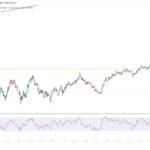Moody’s U.S. Debt Downgrade: Does It Really Change Anything for Stocks and Bonds?
A wildfire of headlines is sweeping markets in response to Moody’s downgrade of U.S. debt, but a calmer, history-informed view helps separate fear-driven narration from fundamentals. This piece delves into Moody’s rationale, contrasts past credit downgrades by major agencies, and analyzes how stocks and bonds have behaved in similar moments. It also weighs the macroeconomic trajectory of U.S. debt, the potential policy responses, and the practical implications for investors’ portfolios. The goal is to understand what the downgrade signals—and what it does not—so investors can navigate the coming months with clarity and disciplined risk management.
Moody’s downgrade explained
Moody’s issued a one-notch downgrade on its long-standing rating scale, indicating a shift in the United States’ debt discipline that aligns more closely with its peers. On its 21-step rating framework, the downgrade reflects the sustained growth in government debt and the rising proportion of annual interest payments relative to the economy. Moody’s described the move as a reflection of an extended period during which debt-service burdens have risen to levels that outpace those of similarly rated sovereigns. The agency emphasized that, after more than a decade, the U.S. has not only accumulated higher debt but also faced persistent pressure from rising interest expenses that are not easily tamed by current policy proposals.
Historically, Moody’s had held the U.S. at the very highest rating while some rivals had already lowered their assessments. The decision to re-rate the United States in line with the broader global rating landscape marks a notable shift for the agency, given its 116-year history of credit assessments. In explaining the downgrade, Moody’s underscored a fundamental belief: despite the strength of U.S. institutions and the depth of its capital markets, fiscal policy has repeatedly failed to reverse a long-term trajectory of deficits and rising interest costs. The downgrade does not imply an imminent default or a collapse in market access but signals a reconsideration of the long-run sustainability of current fiscal paths.
The central economic argument Moody’s highlights is that successive U.S. administrations and Congress have not enacted measures to reverse the trend of large annual deficits and the rising cost of servicing the debt. The agency stated plainly that it does not believe material, multi-year reductions in mandatory spending and deficits will materialize under the fiscal proposals currently under consideration. This assessment traces back to the broader macroeconomic context: the combination of persistent deficits, growing interest payments, and political dynamics that have produced episodic funding actions rather than sustained fiscal consolidation.
To understand the underlying mechanics, it helps to recall the structural background of U.S. fiscal policy over the past decade and more. Since the 2008 financial crisis, the United States has faced pressures from aging demographics, rising entitlement commitments, and slower improvements in revenue growth relative to spending. The practical outcome has been a pattern of continuing budget shortfalls and a reliance on short-term continuing resolutions to avert immediate funding gaps. This pattern, in Moody’s view, has allowed debt to accumulate without a durable plan to reduce the exposure to future interest costs. The rating action, then, is a reflection of credit trends rather than a comment on near-term liquidity or the odds of a technical default.
In the context of the debt downgrade, it is important to separate the symbolism of the rating change from the practical implications for daily market functioning. The downgrade does not erase the market’s confidence in U.S. debt instruments, nor does it abolish the well-established status of U.S. Treasuries as a benchmark for risk-free assets in many portfolios. The downgrade specifically targets the projected fiscal trajectory and governance dynamics that shape long-term debt sustainability. For investors, the key takeaway is to recognize that the downgrade is a long-horizon signal about the sustainability of deficits and debt-service costs, not a near-term crisis trigger.
Moody’s argument also highlights the structural tension between the country’s status as the world’s primary reserve currency and the domestic fiscal path that has produced higher debt levels. The downgrade does not automatically translate into a dramatic shift in the appetite for U.S. government securities, but it does raise questions about how institutions and markets will price risk relative to the evolving fiscal reality. Investors should view the downgrade as part of a broader conversation about debt dynamics, macroeconomic resilience, and policy effectiveness, rather than as a singular event that immediately disrupts the capital markets.
Historical context: S&P 2011 and Fitch 2023
To gauge the potential market implications, it is instructive to review how previous downgrades played out in the stock and bond markets. The most notable comparison is Standard & Poor’s downgrade of the U.S. debt to AA+ from AAA in August 2011. S&P’s assessment at the time argued that the plan recently reached by Congress and the Administration did not meet what the agency viewed as necessary to stabilize the government’s medium-term debt dynamics. The downgrade occurred during a period when the debt ceiling debates dominated headlines, and it came amid concerns about governance and the political process in Washington.
The immediate market reaction in 2011 was complex and often misunderstood in real time. Headlines indeed carried a heavy dose of fear and speculation about a potential dollar collapse, a severe recession, and a rolling stock market rout. Yet, the broader empirical pattern showed a more nuanced outcome. While equity markets experienced a brief correction, the downward move did not presage a collapse in the stock market, and the bulls eventually reasserted control as macroeconomic drivers evolved. Bond yields moved higher in the wake of the downgrade, but the Treasury market remains deeply liquid and widely viewed as a global safe haven. The dollar often strengthened in some contexts, though not uniformly, and gold’s behavior was mixed, initially rising before giving back gains over time. The net effect, in hindsight, was not the catastrophe that some headlines suggested.
Fitch’s downgrade of the U.S. to AA+ from AAA in August 2023 added another layer to the historical frame. Fitch cited the expected fiscal deterioration over the next three years, a high and rising general government debt burden, and a perceived erosion of governance relative to higher-rated peers. The rationale mirrored concerns about long-term debt dynamics and repeated debt-limit standoffs, underscoring a consensus among major rating agencies that governance and fiscal strategy had not stabilized the debt trajectory. The U.S. Treasury publicly pushed back against Fitch’s analysis, maintaining that the agency’s conclusions were flawed and that the broader market would determine borrowing costs more than rating judgments would.
Within the historical arc, several common threads emerge. First, the rating actions themselves have tended to reflect structural concerns about deficits, debt accumulation, and governance rather than signaling an imminent liquidity crisis. Second, the near-term market responses have often included some degree of volatility, particularly in equities and fixed-income futures, but these moves have frequently been followed by a return to trend as macroeconomic fundamentals reassert themselves. Third, the long-run resilience of Treasuries and the dollar as a reserve asset means that downgrades seldom catalyze a complete loss of confidence or a systemic crisis. In other words, downgrades have functioned more as narrative catalysts than as decisive catalysts of market outcomes.
Historical analysis also shows a recurring dynamic: downgrades often coincide with, or even precede, a period of rebalancing where risk assets correct from overbought conditions, only to re-accelerate as growth, inflation, and policy expectations evolve. In 2011, the stock market’s initial pullback adjusted into a prolonged bull trend that extended into the following year, supported by a resilient consumer, improving corporate earnings, and a normalization of yields after a transient spike. In 2023, the pattern was more complex, with the market navigating the combined effects of high inflation, a tightening monetary stance, and a shifting regulatory environment. The key takeaway across both episodes is that downgrades are part of a broader, longer-running cycle in which policy, macro fundamentals, and investor psychology interact in ways that can blur the immediate impact of a credit rating change.
Market reactions then and now: stocks, bonds, and currencies
A critical dimension of downgrades is how different asset classes respond in the aftermath. In 2011, markets initially reacted with a sense of risk aversion. Equity indices retreated in the short term, and the bond market experienced a sell-off that pushed yields higher on the news. However, this was followed by a protracted period of recovery as investors reassessed the macro landscape, the economy regained momentum, and corporate earnings added ballast to risk assets. The U.S. dollar strengthened in some environments, and gold’s performance was not uniform across time, clarifying that the flight-to-safety narrative can be tempered by the broader macro context.
The S&P downgrade did not erase the United States’ standing as a cornerstone of global finance. The U.S. Treasury market continued to be the premier benchmark for risk-free rates, and the long-run outlook for Treasuries remained anchored by expectations about inflation, economic growth, and the demand for safe assets. In the wake of the downgrade, some investors recalibrated portfolios to emphasize quality, liquidity, and duration management, but the overall risk premium on government debt did not surge to catastrophic levels. This pattern—an initial sensitivity followed by a stabilizing reversion—has been a recurring theme in major credit downgrades, especially when the underlying economy remains structurally sound and policy uncertainty is gradually resolved.
In the more recent downgrade scenario, market dynamics have shown a similar diversity of responses. Equity markets often exhibit a short-term pullback after the downgrade announcement, particularly when sentiment is stretched and momentum indicators show overbought conditions. Yet the longer arc frequently depends on whether earnings growth remains robust, whether inflation cools, and how the Federal Reserve (or other central banks) calibrates policy signals in response to the evolving debt story. On the debt side, yields tend to move in the direction dictated by the immediate balance between growth expectations and the perceived risk of higher financing costs. The broader lesson is that downgrades are not binary shocks; they interact with a mosaic of macroeconomic forces that shape the trajectory of markets in the weeks and months after the news.
Beyond the immediate price actions, a key question for investors is how the downgrade affects the incentive structure for risk-taking and capital allocation. If the market remains confident in the resilience of U.S. earnings and the durability of demand, equities can still deliver gains even in a higher-rate environment. Conversely, if the debt trajectory translates into tighter financial conditions or slower growth, fixed-income markets may respond with a more persistent bias toward higher yields and longer-duration strategies that balance risk and reward. In short, downgrades tend to move markets temporarily but do not, by themselves, determine the long-run course of stocks or bonds; the broader economic fundamentals and policy responses ultimately steer outcomes.
In evaluating the near-term implications, it is helpful to consider the role of bank regulation and monetary policy in shaping yields and credit conditions. For example, discussions around the supplementary leverage ratio, or SLR, reflect ongoing debates about how capital rules influence banks’ willingness and ability to hold Treasuries and extend credit. Banks have long argued that tighter SLR requirements can impede lending and limit demand for Treasury securities, which in turn can influence market dynamics. If policymakers adjust these rules or provide temporary relief, the demand for Treasuries could rise, potentially supporting prices and dampening yields during periods of economic stress. Conversely, if yields rise due to stronger growth or higher inflation, banks may intensify their pace of asset reallocation, which could push yields higher again. These interplays illustrate how regulatory decisions can interact with debt dynamics to shape market outcomes in the months ahead.
The debt trajectory and macro implications
The macroeconomic backdrop to Moody’s downgrade centers on a persistent expansion of the debt burden and the corresponding costs of servicing that debt. Since the 2008 financial crisis, fiscal deficits have remained large, and growth in mandatory spending has persisted alongside rising interest payments. The Congressional Budget Office (CBO) has routinely projected that the debt-to-GDP ratio will continue to rise, reflecting both slower potential growth and sustained deficits. In the current conversation, the long-term challenge is not only current debt levels but the path those levels trace through the next decades.
A key concept that frequently surfaces in this discussion is “debt sustainability.” If debt grows faster than the economy over an extended period, the burden of debt service can become a more meaningful drag on growth. When interest rates rise or inflation accelerates, the cost of financing debt can crowd out productive spending, reduces capital available for investment, and restrains economic expansion. The narrative of “Japanification”—a term used to describe a situation in which persistent high debt levels coincide with slow growth and structurally subdued inflation—appears in some analyses as a cautionary tale. The comparison to Japan’s post-1990 trajectory—where decades of debt expansion did not translate into strong, sustained growth—serves as a potential risk scenario for the United States if debt accumulation continues without a corresponding improvement in economic productivity.
Supporters of the current framework often point to the resilience of U.S. institutions, the credibility of the Treasury debt market, and the ongoing global trust in the U.S. dollar as stabilizing forces. They argue that even with elevated deficits, debt crises have historically been avoided because the Treasury market remains deep, liquid, and widely recognized as the safest collateral in many contexts. The reserve currency status of the U.S. dollar, in particular, acts as a buffer against the most extreme mispricings, offering ongoing demand for Treasuries from foreign and domestic buyers alike. In this view, downgrades reflect perceptions about fiscal policy rather than a genuine, imminent threat to debt service capabilities.
Still, the macro drivers warrant careful attention. The CBO’s long-range projections point to a trajectory in which debt levels rise further relative to GDP, especially if a combination of persistent deficits and rising interest costs persists. The implication for macroeconomic performance is nuanced. Higher debt service reduces the resources available for productive private investment, which can dampen potential growth over time. Yet if the economy experiences solid growth, inflation remains manageable, and the policy response supports productive investment, some of the risk can be mitigated. The balance between these forces—growth, inflation, policy credibility, and the debt path—will shape the medium- and long-term outlook for both stocks and bonds.
From a policy perspective, investors should monitor fiscal proposals, debt-ceiling dynamics, and governance reforms that could alter the trajectory of deficits. The debate over whether current proposals would meaningfully reduce deficits or merely offer temporary relief is central to assessing long-run risk. In the near term, however, the market often prices in a breadth of scenarios, including the possibility of renewed fiscal consolidation or, conversely, renewed fiscal expansion depending on political developments and economic conditions. The crucial takeaway is that debt dynamics are a forward-looking variable that interacts with growth, inflation expectations, and financial conditions to shape asset prices over time.
Near-term outlook for stocks and bonds: what to watch
Given the current environment, the combination of a debt downgrade and a market that has recently stretched technical indicators creates a setup that warrants careful observation. In equities, forward-looking momentum and relative strength metrics have been elevated, with many indices trading well above short-term moving averages. The risk of a near-term pullback is present, particularly if external shocks or earnings disappointments appear. However, such pullbacks can also serve as healthy, corrective mechanisms that align prices with underlying fundamentals, creating opportunities for longer-term investors to add exposure at more attractive price levels.
On the bond side, yields have responded to the downgrade as markets reassess the relative risk and the trajectory of policy. Historical patterns show that yields can move higher on the news before reversing as real growth and inflation dynamics reassert themselves. If inflation continues to ease and the Federal Reserve moderates its tightening stance, yields may soften from those immediate highs. Yet if growth remains resilient or if market expectations shift toward tighter liquidity, yields could persist at elevated levels for longer. The possibility that policy changes, including adjustments to bank capital requirements, could influence the demand for Treasuries adds another layer of complexity to the near-term outlook.
In the backdrop, there are several technical and structural dynamics worth watching. First, the potential changes to the supplementary leverage ratio (SLR) could alter banks’ capacity to hold and trade Treasuries, with implications for liquidity and price discovery in the Treasury market. Second, the market’s positioning—particularly any indicators of a large short position in Treasuries—could lead to more pronounced moves if a shift in perceptions about growth, inflation, or policy occurs. Third, macro data, including inflation prints, wage growth, and consumer spending, will continue to drive expectations about the path of interest rates and the slope of the yield curve. Taken together, these factors suggest a period of heightened sensitivity to news, but not an automatic collapse of risk assets.
Analysts also highlight that the debt downgrade does not alter the fundamental status of U.S. debt as a reliable benchmark, nor does it erase the long-standing role of Treasuries in diversified portfolios. The U.S. remains the world’s largest economy, with a deep and liquid debt market and a framework of monetary policy that has historically contained risk through a combination of rate adjustments and balance-sheet tools. For investors, the practical implication is to focus on disciplined positioning rather than reactive trading. This means aligning exposure with risk tolerance, maintaining diversified strategies, and using prudent risk-management tools such as diversified asset allocation, stop-loss orders at sensible levels, and clear rebalancing rules.
Portfolio implications and risk management
From a portfolio-management perspective, the downgrade is a reminder that fiscal trajectories shape market environments over the medium to longer term, even if they do not trigger immediate crises. Investors should consider reinforcing risk controls, rebalancing toward target weights, and maintaining flexibility to adjust as conditions evolve. Given the tendency for markets to overreact in the short term, it is prudent to re-evaluate concentration risk, liquidity, and the balance between equities and fixed income in the context of a slower growth, higher debt environment.
Key actions to consider include the following:
- Rebalance toward target risk exposure while ensuring that equity and bond allocations reflect current economic and policy expectations.
- Tighten stop-loss levels to align with current support levels on individual positions, preventing outsized losses in volatile periods.
- Hedge against significant market drawdowns by using risk-managed strategies that preserve capital during downturns.
- Take profits on positions that have delivered outsized gains, and reallocate proceeds toward more robust, fundamentally-driven opportunities.
- Sell laggards and trim positions that no longer align with the strategic thesis or exhibit deteriorating fundamentals.
- Raise cash and reassess the portfolio’s risk-reward balance, especially if the market shows signs of persistent overbought conditions.
- Focus on stocks and sectors with durable earnings power, strong balance sheets, and the potential to outperform in a higher-rate, slower-growth environment.
- Monitor macro indicators, including inflation, wage growth, and growth trajectories, as well as policy signals from the Federal Reserve and Congress, to adjust duration, quality, and sector tilt accordingly.
Investors should anchor decisions in a disciplined framework rather than headlines. The goal is to navigate near-term volatility while preserving the ability to participate in the upside in a manner that matches the investor’s risk tolerance, time horizon, and liquidity needs. In this context, the downgrade is less a call to panic and more a prompt to reassess asset allocation, risk controls, and tactical opportunities that arise from shifting market dynamics.
Conclusion
The Moody’s downgrade of U.S. debt is a meaningful signal about the long-run sustainability of the nation’s fiscal path, not a doomsday forecast. History shows that credit downgrades, including S&P’s 2011 move and Fitch’s 2023 action, have produced periods of short-term volatility but have not, in themselves, precipitated a collapse in the core assets that underpin global finance. The U.S. dollar’s reserve currency status, the enduring credibility of U.S. Treasury markets, and the broader strength of the economy continue to shape outcomes in the near term.
For investors, the prudent course is to acknowledge the longer-run debt dynamics while focusing on what can be controlled in the here and now. A measured approach—characterized by disciplined risk management, thoughtful rebalancing, and a readiness to exploit selective opportunities—offers a credible path through a period of potential pullbacks and renewed volatility. In the longer horizon, the trend of debt growth will demand continued attention to growth, inflation, policy credibility, and the efficiency of public spending. If the economy can sustain healthy growth and inflation remains moderate, the Dow or S&P may continue to trend higher, and bond markets may stabilize as yielding conditions normalize. In this light, the downgrade does not erase opportunity; it reframes risk and reinforces the importance of a robust, well-structured investment strategy that can adapt to evolving fiscal and macroeconomic realities.



